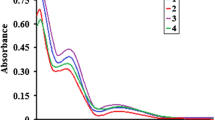Summary
Copper(I) complexes [CuClL]2 (L=Py, 4-PhPy, 4-MePy, 4-Me2NPy, and 4-PhCOPy) react with dioxygen in dichloromethane according to the rate law: r=KD 1/2 k2 [CuClL]2 1/2[O2] where KD is the dissociation constant of the equilibrium [CuClL]2 ⇋2 CuCIL and k2 the second order rate constant of the reaction of the latter with dioxygen.
The KD values were determined by molecular weight measurements in dichloromethane and a correlation has been developed between the experimental rate constants obtained and the acid dissociation constants (pKa) for the ligands. The reaction fits a Hammett linear free energy relationship and the rate-determining step is attributed to the first electron transfer to the dioxygen molecule from the mononuclear copper(I) complex, which is influenced by changes in the electron density on the copper.
Similar content being viewed by others
References
A. D. Zuberbühler in H. Sigel (Ed.)Metal Ions in Biological Systems, Vol. 5, Dekker, New York, 1976 p. 325.
A. S. Hay,J. Org. Chem., 25, 1275 (1960).
H. Finkbeiner, A. S. Hay, H. S. Blanchard and G. F. Endres,J. Org. Chem., 31, 549 (1966).
H. Takahashi, T. Kajimoto and J. Tsuji,Synth. Commun., 2, 181 (1972).
J. Tsuji, H. Takayanagi,Tetrahedron Lett., 1365 (1976).
J. Tsuji, H. Takayanagi,J. Am. Chem. Soc., 96, 7349 (1974).
M. M. Rogič and T. R. Demmin,J. Am. Chem. Soc., 100, 5472 (1978).
G. Speier and Z. Tyeklár,React. Kinet. Catal. Lett., 15, 91 (1980).
P. M. Henry,Inorg. Chem., 5, 688 (1966).
S. Ito, T. Yamamoto and Y. Tokushige,Chem. Lett., 1411 (1980).
E. Tsuchida, M. Kaneko and H. Nishide,Makromol. Chem., 151, 221 (1972).
G. Condurier, H. Praliaud and M. V. Mathieu,Spectrochim. Acta, 30A, 1399 (1974).
G. Speier and Z. Tyeklár, submitted for publication.
C. E. Kramer, G. Davies, R. B. Davies and R. W. Slaven,J. Chem. Soc., Chem. Comm., 606 (1975).
I. Bodek and G. Davies,Inorg. Chim. Acta, 27, 213 (1978).
C. Jallabert, C. Lapinte and H. Riviere,J. Mol. Catal., 7, 127 (1980).
J. A. Arce, E. Spodine and W. Zamudio,J. Inorg. Nucl. Chem., 37, 1304 (1975).
J. A. Arce, E. Spodine and W. Zamudio,J. Inorg. Nucl. Chem., 38, 2029 (1976).
A. L. Crumbliss and L. J. Gestant,J. Coord. Chem., 5, 109 (1976).
J. Divisek and B. Kastering,J. Electroanalyt. Chem., 65, 603 (1975).
M. E. Peover and B. S. White,Chem. Comm., 183 (1965).
D. R. Bates and M. S. Massey,Trans. Roy. Soc., H239, 269 (1943).
D. T. Sawyer, J. L. Roberts, jun.,J. Electroanalyt. Chem., 12, 90 (1966).
Author information
Authors and Affiliations
Rights and permissions
About this article
Cite this article
Balogh-Hergovich, É., Speier, G. Reaction of copper(I) chloride pyridine complexes with dioxygen. A kinetic study. Transition Met Chem 7, 177–180 (1982). https://doi.org/10.1007/BF01035837
Received:
Issue Date:
DOI: https://doi.org/10.1007/BF01035837




